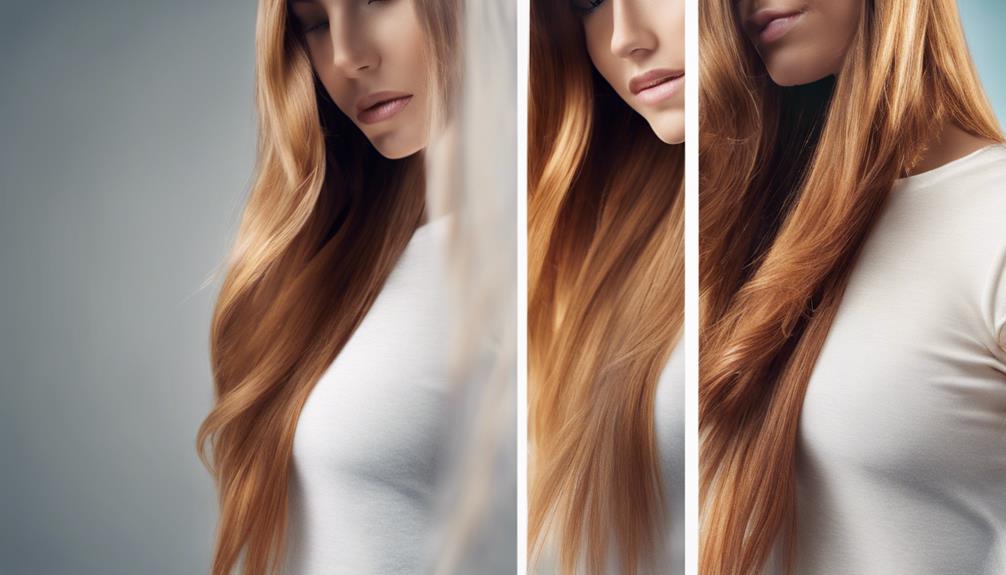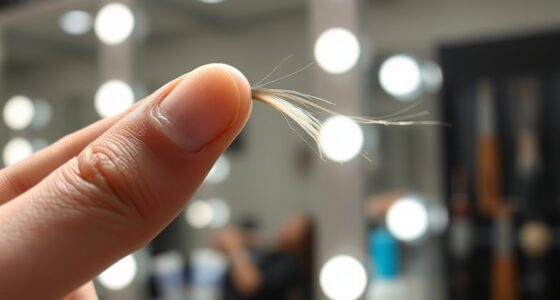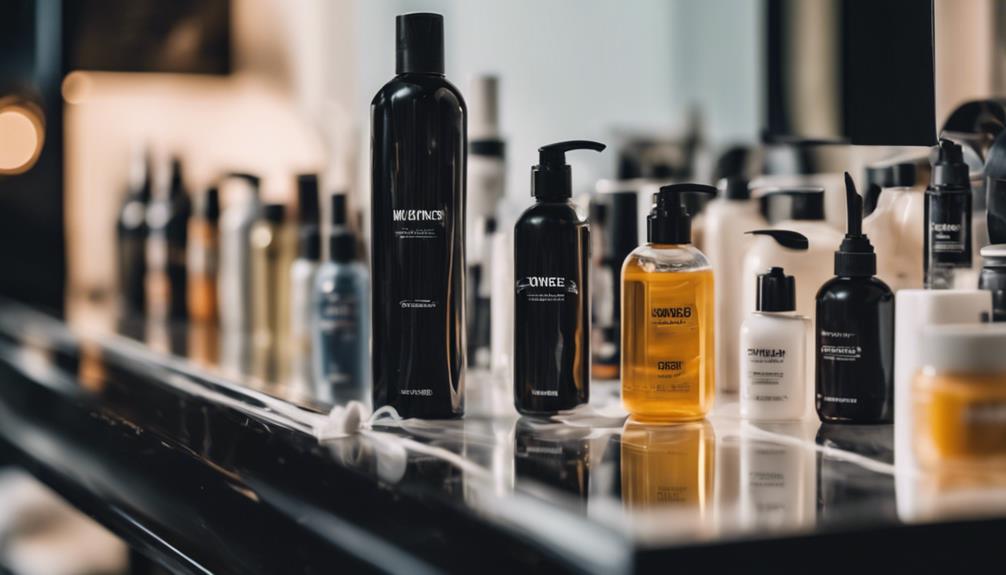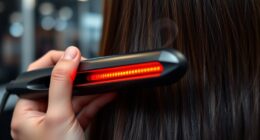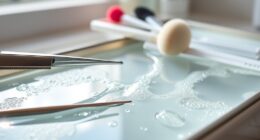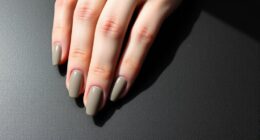After chemical damage, your hair needs urgent repair. To restore hair health, start with protein-based treatments like Redken Acidic Bonding Concentrate Leave-In Conditioner, which strengthens hair. Deep repair treatments like Resistance Masque Extentioniste Hair Mask provide intensive care. Use bond-repairing products like Strength Cure Miracle Filler from Pureology for color-treated hair. Regular trims, pre-shampoo treatments, and gentle care products can also help. Focus on nourishing masks, deep conditioning treatments, and limiting heat exposure. By taking these steps, you'll be on the path to rehabilitating your hair. There's more to explore on this journey to healthy, vibrant locks.
Key Takeaways
• Focus on repairing damage with protein-based treatments like Redken Acidic Bonding Concentrate Leave-In Conditioner to strengthen hair.
• Use deep repair treatments like Resistance Masque Extentioniste Hair Mask to provide intensive care and nourishment.
• Reduce risk of further damage with sulfate-free, paraben-free, and natural hair care products that target chemical damage.
• Incorporate nourishing hair masks, deep conditioning treatments, and regular trims to restore hair health.
• Opt for specialized treatments like protein-infused products and bond-repairing serums to effectively repair and restore damaged hair.
Understanding Chemical Damage
When you subject your hair to chemical treatments like bleaching, dyeing, or using harsh products, you're fundamentally stripping it of its natural defenses, paving the way for a cascade of damaging effects. Chemical damage occurs when these treatments weaken your hair's structure, leading to a range of symptoms including hair breakage, split ends, brittleness, and scalp irritation.
The damage is often cumulative, resulting in thinning, dryness, and loss of elasticity. By understanding the causes of chemical damage, you can take proactive measures to mitigate its effects. This includes selecting appropriate repair treatments and adopting preventive measures to minimize further damage.
In the aftermath of chemical treatments, it's essential to provide your hair with nourishing masks and gentle care to restore its health. By grasping the complexities of chemical damage, you can take the first steps towards restoring your hair's natural vitality.
Repairing Damaged Hair
To restore your hair's health, you'll need to focus on repairing the damage, and that starts with the right treatments. Repairing damaged hair requires a multi-faceted approach that addresses specific hair concerns, such as breakage, dullness, and brittleness.
To start, incorporate protein-based treatments like Redken Acidic Bonding Concentrate Leave-In Conditioner to strengthen weak and damaged hair. Deep repair treatments, such as Resistance Masque Extentioniste Hair Mask with creatine and ceramides, provide intensive care for weakened hair. For color-treated hair, use bond-repairing products like Strength Cure Miracle Filler from Pureology to strengthen and protect.
Some key steps to include in your repair routine are:
- Regular trims to cut damaged ends
- Pre-shampoo treatments to nourish and moisturize
- Tailoring treatments to address specific hair concerns
- Using products that target chemical damage and weak hair
Essential Care Tips
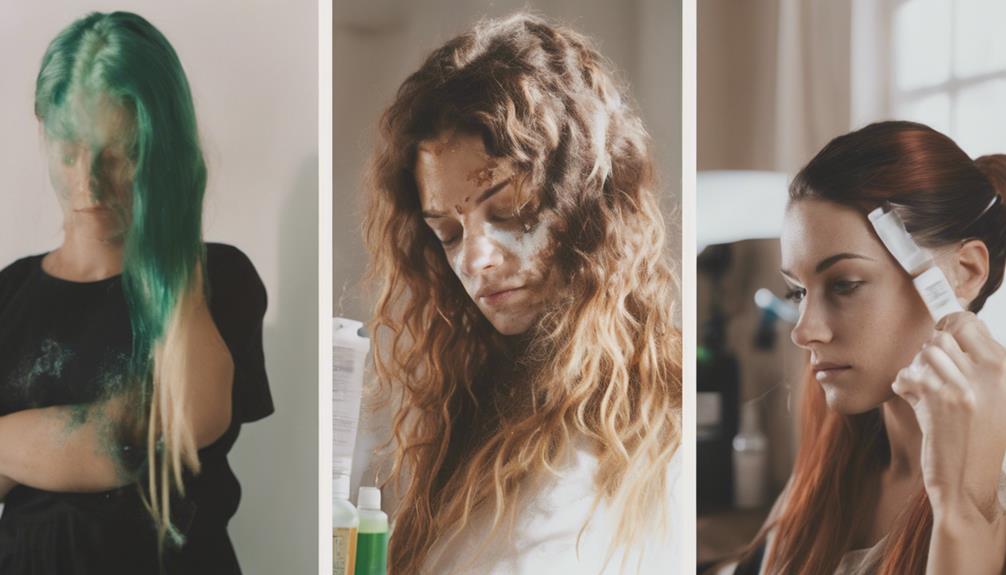
By adopting a few essential care habits, you can greatly reduce the risk of further damage and promote healthy hair growth. To prevent further damage, choose sulfate-free, paraben-free, and natural hair care products that are gentler on your hair. It's also important to wait between chemical treatments to allow your hair to recover and reduce potential damage.
Limit heat exposure, avoid excessive brushing, and opt for gentler hair care routines to minimize damage. Incorporate nourishing hair masks and deep conditioning treatments to restore moisture and hydration. Consider professional in-salon treatments like Kérastase Fusio-Dose or Redken Shades EQ Bonder Inside for improved hair health.
Product Selection Guide
Selecting the right products is essential in restoring your hair's health, so focus on sulfate-free shampoos and paraben-free conditioners that gently cleanse and nourish your locks.
When choosing hair care products to Repair Chemically Damaged hair, consider the following:
- Look for nourishing ingredients like coconut oil, Argan oil, and silk proteins to restore moisture and strength.
- Opt for deep conditioning masks and leave-in treatments to repair and protect hair from future damage.
- Consider specialized treatments like protein-infused products and bond-repairing serums for intensive repair of chemically damaged hair.
- Explore a variety of options tailored to specific hair concerns, such as breakage, dryness, and brittleness, for effective restoration of hair health.
Restoring Hair Health

With your hair care routine in place, it's time to focus on restoring your hair's health, and that starts with targeted treatments that address the specific damage inflicted by chemical processing. To repair and strengthen your damaged strands, incorporate protein masks into your regimen. These treatments will help repair and strengthen your hair fibers, paving the way for healthier locks.
| Treatment | Benefits |
|---|---|
| Protein Masks | Repair and strengthen weakened hair fibers |
| Oil-Based Treatments | Boost shine and shield hair from further damage |
| Revitalization Serums | Promote strong hair growth from the root |
For added nourishment, try oil-based treatments like L'Oréal Professionnel Metal Detox Oil, which will boost shine and shield your hair from further damage. Color-treated hair treatments, such as Pureology Strength Cure Miracle Filler, can strengthen and protect your hair while maintaining color vibrancy. Finally, leave-in treatments like Total Results Instacure Anti-Breakage Porosity Spray can fill in gaps in your hair's structure, control frizz, and strengthen damaged strands. By incorporating these treatments into your routine, you'll be well on your way to restoring your hair's health and achieving the strong, vibrant locks you deserve.
Frequently Asked Questions
How to Repair Severely Chemically Damaged Hair?
When dealing with severely chemically damaged hair, you'll want to take a multi-step approach to repair and restore it. Start by incorporating professional protein treatments to strengthen weak fibers.
Follow this up with oil-based treatments like L'Oréal Professionnel Absolut Repair 10 in 1 Oil to soften and restore damaged locks.
Additionally, use hair revitalization serums, such as Kérastase Resistance Sérum Extentioniste Scalp & Hair Serum, to promote strong hair growth from the root.
How to Regrow Hair After Chemical Damage?
To address how to regrow hair after chemical damage, start by understanding that regrowth is dependent on the extent of damage and individual hair growth cycles.
Be patient, as regrowth can take time – typically ranging from a few weeks to several months.
Under medical guidance, use hair growth treatments like minoxidil to stimulate regrowth.
Additionally, maintain a healthy diet, reduce stress, and follow a gentle hair care routine to support regrowth efforts.
Can You Reverse Chemical Damage to Hair?
You can't completely reverse chemical damage to your hair, unfortunately. The damage is irreversible, and it's essential to accept that.
However, you can take steps to improve its appearance and health. By using targeted treatments, deep conditioning, and bond-repairing products, you can strengthen and protect your hair.
With consistent care and gentle handling, you can promote healthier growth and manage the damage.
How Do You Restore Super Damaged Hair?
As you struggle to revive your super damaged hair, consider the story of Sarah, who restored her over-processed locks with a combination of protein treatments and oil-based serums.
You can follow her lead by incorporating products like L'Oréal Professionnel Absolut Repair 10 in 1 Oil into your routine. This will help strengthen and revitalize your hair, filling in gaps and protecting it from further damage.
Conclusion
As you've learned, chemical damage can be devastating to your hair, but with the right remedies and care, you can restore its health. Some of the best treatments for damaged hair include deep conditioning masks, protein treatments, and avoiding heat styling tools. It’s also important to trim off any split ends and limit the use of harsh chemicals or dyes. By taking these steps and being patient with the healing process, your hair can once again become strong and healthy.
One potential objection is that repairing damaged hair takes too long; however, with consistent effort and the right products, you can see significant improvement in a few weeks.
By following the tips and guidelines outlined above, you'll be on your way to revitalizing your locks and enjoying strong, healthy hair once again.
